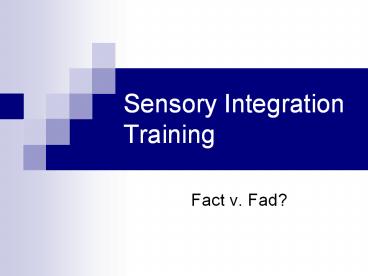Sensory Integration Training - PowerPoint PPT Presentation
Title:
Sensory Integration Training
Description:
Sensory Integration Training Fact v. Fad? Sensory Integration Dysfunction (SID) Children with SID frequently experience problems with their sense of touch, smell ... – PowerPoint PPT presentation
Number of Views:576
Avg rating:3.0/5.0
Title: Sensory Integration Training
1
Sensory Integration Training
- Fact v. Fad?
2
Sensory Integration Dysfunction (SID)
- Children with SID frequently experience problems
with their sense of touch, smell, hearing, taste
and/or sight. Also often experienced ifficulties
in movement, coordination and sensing where one's
body is in a given space. - Common disorder for individuals with neurological
conditions such as an autism spectrum disorder. - Individuals may be overly sensitive to certain
textures, sounds, smells and tastes, while
wearing certain fabrics, tasting certain foods,
or normal everyday sounds may cause discomfort. - The opposite is also possible - for example a
child with an autism spectrum disorder may feel
very little pain or actually enjoy sensations
that neurotypical children would dislike strong
smells, intense cold or unpleasant tastes.
3
Sensory Integration Therapy w/ Children
- Occupational therapy with child placed in a room
specifically designed to stimulate and challenge
all of the senses. During the session, the
therapist works closely with the child to
encourage movement within the room. The therapy
is driven by four main principles - the child must be able to meet the challenges
through playful activities - the child adapts behavior to meet the challenges
presented - the child will want to participate because the
activities are fun - the child's preferred activities are used in the
session - Careful to not provide children w/ more sensory
stimulation than they can cope with. The
occupational therapist looks for signs of
distress.
4
Examples of Sensory Integration Treatments
- Prism lenses
- Physical exercise
- Auditory integration training
- Sensory stimulation or inhibition techniques such
as "deep pressure"firm touch pressure applied
either manually or via an apparatus such as a hug
machine or a pressure garment. - Weighted vests, a popular deep-pressure therapy,
have only a limited amount of scientific research
available, which on balance indicates that the
therapy is ineffective.
5
Examples Sensory Integration Therapy
- Sense of touch varies widely between children
experiencing SID. - When children enjoy the feel of sticky textures,
the therapist may use materials such as glue,
play dough, stickers, rubber toys and sticky
tape. - Other materials that can be useful for tactile
sensation include water, rice, beans and sand. - Children on the autism spectrum often enjoy a
sense of firm overall pressure. - Interventions wrapping them up in blankets,
being squashed by pillows and firm hugs. - Experiences that may be claustrophobic for
neurotypical children may be enjoyed, such as
being squashed between mattresses, and making
tunnels or tents from blankets over furniture.
6
Common Examples in Schools
- Sensory Rooms
- Some pictures of sensory rooms
- http//teachinglearnerswithmultipleneeds.blogspot.
com/2008/02/sensory-rooms-on-cheap-revisited.html - Aka -- Snoezelen Rooms
- Occupational Therapists usually suggest practices
7
What does the Research Say?
8
Sensory Integration Training (SIT)
- Leong Carter (2008)
- Review of the Research on SIT
- Examined past key reviews of SIT intervention
studies through 1994 - Then examined SIT intervention studies from
1994-2007 - Findings
- Consistent w/ numerous previous reviews, no
robust evidence supporting the efficacy of SIT
was found - In light of the accumulated lack of evidence for
the effectiveness of SIT, continued use of the
techniques outside of research contexts does not
appear to be justified
9
SIT Research Summary
- SIT is used widely across groups including
- Learning disabilities
- Intellectual disabilities
- Autism Spectrum Disorders
- Though research dates back 40 years, SIT has yet
to be proven effective for any of these groups































